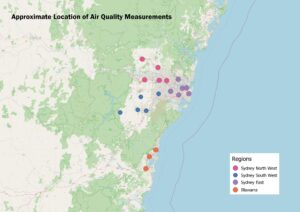Sydney’s air quality is improving and with good policy the effects could be long lasting
Over the past few weeks in a bid to reduce the spread of Covid-19, offices have closed, visitors have been forced to self-isolate on arrival and non-essential businesses have been restricted to operating remotely or halting operations. The impact of millions fewer people moving around as a result can already be seen in Sydney’s air quality.
The NSW Department of Planning, Industry and Environment publishes detailed data on air quality measurements around New South Wales. These are updated in real time and offer insight into how people are reacting to lockdown, with an improvement in air quality perhaps an inadvertent benefit of a global pandemic. One measure, the Air Quality Index (AQI), uses information on five air pollutants[1] and visibility to show how clean or polluted the air in a specific location is. This is available as a daily or hourly average across a range of locations in NSW.
Emissions from transport are a key contributor to air quality. In a bid to reduce the spread of Covid-19 the NSW Government has implemented a range of measures which could all be contributing to an improvement in air quality. Three key policies work together to reduce the overall number of trips taken around the city and emissions and as such, improvements in air quality.
Using the AQI data, we tested whether an improvement in air quality is currently occurring. Looking at daily averages for March in 2020 compared to daily averages in March over the last 10 years we found that Sydney East and Sydney North West regions show a statistically significant reduction in the AQI compared to historic values, representing an improvement in air quality. Sydney South West and Illawarra also showed reductions, but they were not found to be statistically significant. This suggests that in just a short space of time, air quality is improving in some of Sydney’s busiest regions.
Why are the results different across regions?
There are three potential reasons why results differ by region. Firstly, Sydney East and North West regions cover locations such as Parramatta, Randwick and Rozelle which house or attract high numbers of workers in the service sector, tourists or both. They were also among the first areas to respond to restrictions with many businesses advising working from home before formal restrictions were in place. For this reason, the March data may be picking up changes made earlier than for other areas which waited for official announcements (21st March for the first rules on social distancing to come into force) before changing behaviour.
Secondly, the availability and use of public transport may affect the extent to which air quality will change. Public transport services continue to operate, albeit on a reduced service and with restrictions in place. Regions where households are more dependent on cars for travel and who are unable to work from home will continue to make these journeys by car, therefore reducing the likelihood of an improvement in air quality, at least in the short term while journeys are falling.
Finally, the air quality index may provide some insight into how seriously residents are taking the measures. “Non-essential journeys” leaves some room for interpretation, as do social distancing guidelines. A significant improvement in air quality for one location could suggest that recommendations are being closely followed, whilst less change in other areas hints that people are continuing more like business as usual.

Detailed traffic data is not yet available for recent weeks. However, data from TomTom[1] is showing a fall in congestion which is especially apparent during what would normally be peak hour traffic. Congestion on a weekday morning is approximately 24% lower than average, with peak congestion reaching around 20% compared to its usual 60%. Interestingly, the increase in traffic appears to be slightly later than normal, potentially a result of people changing shift patterns or departure times because journeys are quicker to complete. As travel count statistics, road accidents data and other information becomes available, we are likely to see other patterns emerging, potentially shedding some positivity on the current crisis.
Maintaining improvements requires good policy
Whilst improvements in air quality are good, when the cause is a global pandemic, they are unlikely to be long lived. Indeed, some evidence suggests that after economic downturns emissions increase as governments try to boost their economy through stimulus spending which inevitably supports carbon intensive industries, or people rush to catch up on holidays postponed earlier in the year. Government should consider actions which can maintain this improvement in air quality and make the most of an opportunity to reduce emissions once things return to normal.
Some policy options could be based around encouraging aspects of current behaviour to continue. Whilst no-one seems to be enjoying working from home full time, improvements in video conferencing, remote working software and changes in attitudes could encourage more people to ditch the commute on a more regular basis, helping relieve pressure on congested networks and reduce emissions associated with the twice daily trips. Widespread adoption of video conferencing could pave the way for remote working and reduce the need for business flights between cities. Home deliveries and less frequent visits to the supermarket could also be encouraged to continue as a way of reducing emissions from non-essential journeys we normally make. Covid-19 may provide opportunities for positive long-term changes in behaviour which improve the quality of life of people living in major centres.
[1] ozone, carbon monoxide, sulphur dioxide, nitrogen dioxide and airborne particles

